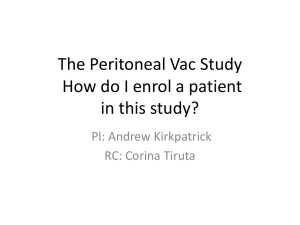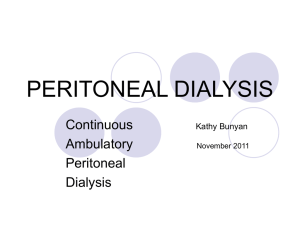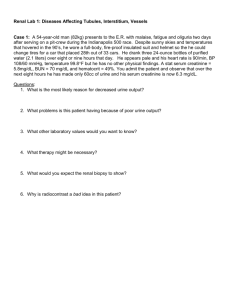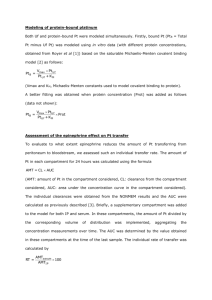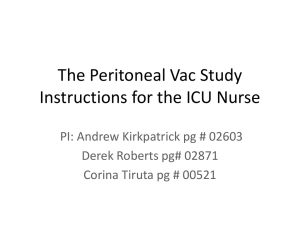Peritoneal fluid
advertisement
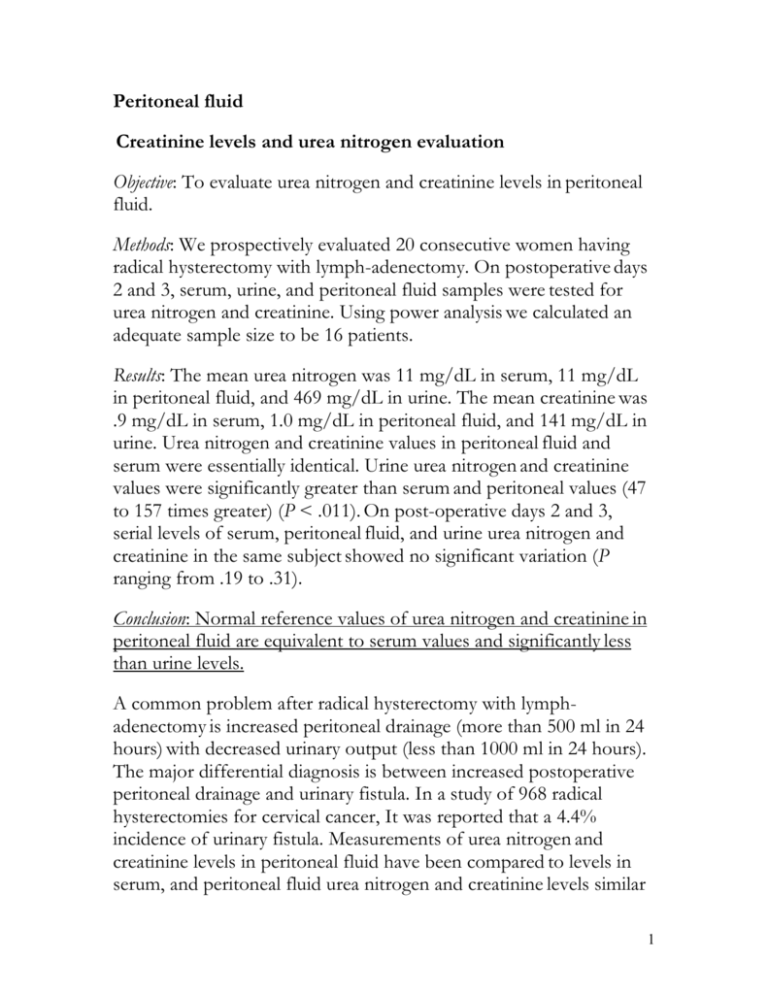
Peritoneal fluid Creatinine levels and urea nitrogen evaluation Objective: To evaluate urea nitrogen and creatinine levels in peritoneal fluid. Methods: We prospectively evaluated 20 consecutive women having radical hysterectomy with lymph-adenectomy. On postoperative days 2 and 3, serum, urine, and peritoneal fluid samples were tested for urea nitrogen and creatinine. Using power analysis we calculated an adequate sample size to be 16 patients. Results: The mean urea nitrogen was 11 mg/dL in serum, 11 mg/dL in peritoneal fluid, and 469 mg/dL in urine. The mean creatinine was .9 mg/dL in serum, 1.0 mg/dL in peritoneal fluid, and 141 mg/dL in urine. Urea nitrogen and creatinine values in peritoneal fluid and serum were essentially identical. Urine urea nitrogen and creatinine values were significantly greater than serum and peritoneal values (47 to 157 times greater) (P < .011). On post-operative days 2 and 3, serial levels of serum, peritoneal fluid, and urine urea nitrogen and creatinine in the same subject showed no significant variation (P ranging from .19 to .31). Conclusion: Normal reference values of urea nitrogen and creatinine in peritoneal fluid are equivalent to serum values and significantly less than urine levels. A common problem after radical hysterectomy with lymphadenectomy is increased peritoneal drainage (more than 500 ml in 24 hours) with decreased urinary output (less than 1000 ml in 24 hours). The major differential diagnosis is between increased postoperative peritoneal drainage and urinary fistula. In a study of 968 radical hysterectomies for cervical cancer, It was reported that a 4.4% incidence of urinary fistula. Measurements of urea nitrogen and creatinine levels in peritoneal fluid have been compared to levels in serum, and peritoneal fluid urea nitrogen and creatinine levels similar 1 to serum levels are believed to be diagnostic of increased peritoneal drainage rather than urinary fistula. The purposes of this study were to measure peritoneal fluid urea nitrogen and creatinine in women who had radical hysterectomy with lymph-adenectomy and to determine the correlation and variability of urea nitrogen and creatinine levels in serum, peritoneal fluid, and urine. Twenty consecutive women who had Rutledge class III radical hysterectomy with bilateral pelvic and periaortic lymph-adenectomy were entered in this prospective trial during 1 year. No potential subjects were excluded. The surgical stapling technique of radical hysterectomy was done on all subjects. An intra-peritoneal suction drain was placed in the deepest part of the pelvis. The drainage catheter exited the skin through a site separate from the surgical incision and was attached to a closed-suction adapter. On postoperative days 2 and 3, 10-mL samples of blood, urine, and peritoneal fluid were collected simultaneously once daily from each subject, placed in redtop chemistry tubes, and sent to the laboratory for measurement of urea nitrogen and creatinine levels. All samples were processed by routine enzymatic and photometric analysis using a LX20 analyzer. The median age of subjects was 47 years (range 22–63 years). Seventeen women had cervical carcinoma and three had endometrial carcinoma with gross cervical involvement. All women had normal preoperative serum urea nitrogen and creatinine levels. None developed clinical evidence of urinary fistulas, evidenced by prolonged, excessive peritoneal drainage or excessive vaginal discharge. The mean urea nitrogen level in serum was 11 mg/dL (range 5–17 mg/dL). The mean creatinine level in serum was 0.9 mg/dL (range 0.5–1.8 mg/dL). The mean urea nitrogen level in peritoneal fluid was 10 mg/dL (range 3–27 mg/dL). The mean creatinine level in peritoneal fluid was 0.9 mg/dL (range 0.5–2.0 mg/dL). The mean urea nitrogen level in urine was 469 mg/dL (range 106–918 mg/dL). The mean creatinine level in urine was 141 2 mg/dL (range 50–290 mg/dL). Among individual subjects, urea nitrogen in peritoneal fluid exceeded that in serum in only two cases, both of which had urea nitrogen level in peritoneal fluid of 14 mg/dL and in serum of 12 mg/dL. Peritoneal fluid creatinine level exceeded serum creatinine in only three cases, in which peritoneal fluid values were .8, .8, and 1.1 mg/dL and serum creatinine values were .7, .6, and .7 mg/dL, respectively. The intra-subject values of urea nitrogen and creatinine in serum, peritoneal fluid, and urine measured on postoperative days 2 and 3. Intra-subject serial serum values of urea nitrogen and creatinine showed narrow ranges, small standard deviations (SDs) (P = .25 and .29, respectively), and good correlations. Intra-subject serial peritoneal fluid values of urea nitrogen and creatinine had narrow ranges, small SDs (P = .19 and .27, respectively), and excellent correlations. Intrasubject serial urine values of urea nitrogen and creatinine had larger ranges and SDs (P = .31 and .22, respectively) and fair correlations. Urea nitrogen levels in serum and peritoneal fluid were nearly identical (P = .94). Urine urea nitrogen mean values were markedly different (47 times greater) from serum and peritoneal fluid values (P < .001). Urea nitrogen levels in serum and peritoneal fluid had excellent correlations, whereas urine and peritoneal levels had poor correlations. Serum and peritoneal fluid values of creatinine were virtually identical (P = .98) and creatinine mean value in urine was markedly different (157 times greater) from that in serum and peritoneal fluid (P < .001). Serum and peritoneal fluid creatinine levels had excellent correlation, whereas urine and peritoneal fluid levels showed poor correlation. We found that postoperative serial peritoneal fluid levels of urea nitrogen and creatinine had limited intra-subject variance, were identical to serum values, and were significantly less than urine values. Although we were unable to identify reference values of urea nitrogen and creatinine in peritoneal fluid, we believe our data show that reference values are equivalent to serum values. Although we logically 3 assumed that reference values of urea nitrogen and creatinine in peritoneal fluid would be equivalent to serum values because physiologic peritoneal fluid is a plasma filtrate, we believe that reference values must be scientifically established because in the present era of scientific medicine, "medicine practiced by intuition or anecdotal experience, which may have been laudable at one time in medical history, is now condemned because it cannot withstand the scrutiny of scientific methods." It was reported that the only clinically significant difference between the surgical stapling technique and traditional technique of radical hysterectomy is decreased operation time and blood loss, so we do not believe that values of peritoneal fluid urea nitrogen and creatinine are influenced by the type of hysterectomy done. It was established that levels of urea nitrogen and creatinine in peritoneal fluid and serum were identical and that urine values were significantly greater (47 to 157 times), when excessive peritoneal fluid was found after radical hysterectomy; therefore, we propose that the measurement of urea nitrogen and creatinine in peritoneal fluid might be a valid initial test to determine intra-peritoneal urinary leakage. If peritoneal fluid values were equal to serum values, then one might follow that woman conservatively. Conversely, if peritoneal fluid values were higher than serum values one might proceed with more extensive radio-logic evaluation to detect possible urinary fistula. There appear to be several situations where measurement of urea nitrogen and creatinine in peritoneal fluid can be clinically beneficial. Excessive postoperative peritoneal fluid, diagnosed by increased suction catheter output or development of pelvic ascites, might occur after gynecologic procedures other than radical hysterectomy, such as surgery for endometriosis, pelvic inflammatory disease, large pelvic masses, or after urogynecologic procedures. Urea nitrogen and creatinine levels in peritoneal fluid can be collected from excessive postoperative peritoneal fluid to determine intra-peritoneal urinary leakage. Measurement of peritoneal fluid urea nitrogen and creatinine can also identify intraperitoneal urine leakage after trauma. In a study 4 on calves, peritoneal fluid levels of creatinine increased 18 times after traumatic urinary bladder rupture. In cases of excessive postoperative suprapubic incisional drainage, measurement of urea nitrogen and creatinine levels might help differentiate urinary leakage from impending incisional dehiscence. Excessive postoperative vaginal drainage might be evaluated by urea nitrogen and creatinine levels to help diagnose postoperative urinary fistulas. 5
